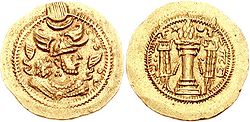Peroz I.
Peroz ( Persian پیروز Pīrūz [ piːˈruːz ]) was a Persian great king . He ruled the late antique Persian Sassanid Empire from 459 to 484 (perhaps as early as 457).
Peroz (who is sometimes also known as Peroz I, as there was later the regionally ruling Sasanid king Peroz II and a pretender to the throne of that name) ascended the throne after a two-year dispute with his rival and brother Hormizd III. , although perhaps not Peroz but Hormizd was the challenger.
The rule of Peroz is generally considered to be a time of serious crisis and his image in the tradition has very contradicting features. The sources attest the king successful measures in view of a catastrophic drought and famine of several years. Furthermore, several cities were founded. In other areas, however, the king was rather unhappy.
Peace could be kept with the Eastern Roman Empire , which itself had to contend with considerable problems at this time, but the Romans repeatedly refused requests for payment with regard to securing the Caucasus passes against nomadic attackers. In Persarmenia there was also (probably 482) an uprising against the Persians.
The situation on the north-eastern border of the Sassanid Empire turned out to be much more serious. Peroz had to deal several times militarily with groups of the " Iranian Huns ". His opponents appear to have been two different groups. The Kidarites , whom Peroz allegedly defeated in 467, come into question for the early phase of the fighting . In 474, however, Peroz then seems to have been involved in battles with the Hephthalites , who now ruled Bactria and brought the king a humiliating defeat; Peroz himself was taken prisoner and had to buy himself out.
In 484 a synod of the Assyrian Church of the East took place in Gundischapur , where the teachings of Nestorius were adopted and the Assyrian Church was thus differentiated from the Church in the Roman Empire. The king was tough on parts of the Jewish community in Persia.
In 484 Peroz broke the peace treaty and attacked the Hephthalites again. The campaign ended in disaster: the Hephthalites had dug a hidden system of trenches on the battlefield (near Baktra?), And when the king and his armored riders attacked, they fell into the trenches and were killed. Most of his brothers and sons died along with Peroz. This spectacular death of a Persian king in battle with external enemies found great echo in the sources (e.g. Prokopios of Caesarea or Tabari ). Peroz's end plunged the Sassanid Empire into the worst crisis in its long history. His brother Balash was elevated to the throne by the nobility, but soon got caught up in a civil war with his nephew Kavadh I.
literature
- Touraj Daryaee: Sasanian Persia . London 2009.
- Nikolaus Schindel, Sylloge Nummorum Sasanidarum . Vol. 3/1 (text volume). Vienna 2004, p. 390ff.
- Klaus Schippmann : Basic features of the history of the Sassanid Empire . Darmstadt 1990.
Web links
- Klaus Schippmann: Peroz I. . In: Ehsan Yarshater (Ed.): Encyclopædia Iranica (English, including references)
Remarks
- ↑ Nikolaus Schindel: Sylloge Nummorum Sasanidarum . Vol. 3/1 (text volume). Vienna 2004, p. 411.
- ↑ Nikolaus Schindel: Sylloge Nummorum Sasanidarum . Vol. 3/1 (text volume). Vienna 2004, p. 411.
- ↑ Nikolaus Schindel: Sylloge Nummorum Sasanidarum . Vol. 3/1 (text volume). Vienna 2004, p. 412.
- ↑ Nikolaus Schindel: Sylloge Nummorum Sasanidarum . Vol. 3/1 (text volume). Vienna 2004, p. 413.
- ↑ Nikolaus Schindel: Sylloge Nummorum Sasanidarum . Vol. 3/1 (text volume). Vienna 2004, p. 413f.
- ^ Nikolaus Schindel: The Sasanian Eastern Wars in the 5th Century. The Numismatic Evidence. In: A. Panaino, A. Piras (Ed.): Proceedings of the 5th Conference of the Societas Iranologica Europaea. Volume I. Milan 2006, pp. 675-689, here pp. 678ff .; Nikolaus Schindel: Sylloge Nummorum Sasanidarum . Vol. 3/1 (text volume). Vienna 2004, p. 414ff.
- ↑ Nikolaus Schindel: Sylloge Nummorum Sasanidarum . Vol. 3/1 (text volume). Vienna 2004, p. 415; rare gold coins actually seem to prove a short-term Sasanid occupation of the eastern Iranian metropolis of Balkh, see here (virtual exhibition The Face of the Stranger ) .
- ↑ Nikolaus Schindel: Sylloge Nummorum Sasanidarum . Vol. 3/1 (text volume). Vienna 2004, pp. 415–417.
- ↑ Nikolaus Schindel: Sylloge Nummorum Sasanidarum . Vol. 3/1 (text volume). Vienna 2004, p. 413.
- ↑ Nikolaus Schindel: Sylloge Nummorum Sasanidarum . Vol. 3/1 (text volume). Vienna 2004, p. 418.
- ↑ Prokopios, Histories I 4.
- ↑ Theodor Nöldeke : History of the Persians and Arabs at the time of the Sasanids. From the Arab Chronicle of Tabari. Translated and provided with detailed explanations and additions . Leiden 1879, p. 125ff.
| predecessor | Office | successor |
|---|---|---|
| Hormizd III. |
King of the New Persian Empire 459–484 |
Balash |
| personal data | |
|---|---|
| SURNAME | Peroz I. |
| ALTERNATIVE NAMES | Peroz; Pīrūz; پیروز (Persian) |
| BRIEF DESCRIPTION | Persian great king |
| DATE OF BIRTH | 5th century |
| DATE OF DEATH | 484 |
